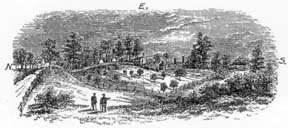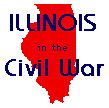

part of a volume entitled History of the Ninety - Third Regiment Illinois Volunteer Infantry: From Organization To Muster Out --Statistics Compiled by Aaron Dunbar Sergeant, Company " B", Revised and Edited by Harvey M. Trimble, Adjutant
Submitted by Jeffrey MacAdam, to whom every reader should be grateful.
| Table of Contents | Previous Page | Next Page |
During the three days following the return from the Yazoo Pass expedition, the Ninety-Third Illinois, still on board the little steamer, laid off the Arkansas shore about five miles below Helena. On the 13th day of April, A. D. 1863, the command again started down the Mississippi River, and reached Milliken's Bend, Louisiana, in the evening of the 15th, and went into camp the next morning, and remained there until the 25th day of the month. During that period preparations were being made for the Vicksburg campaign.
On the night of the 16th of April, Admiral Porter's fleet of gunboats and transports successfully ran the blockade and passed below Vicksburg. The fleet consisted of the gunboat Benton, which was the flagship, the steam ram Lafayette, with a coal barge and the previously captured rebel ram General Price lashed to her, and the gunboats Louisville, Mound City, Pittsburg, Tuscumbia and Carondelet, followed by the transports Silver Wave, Forest Queen and Henry Clay. The transports were loaded with army supplies. Their machinery was protected, as much as possible, by cotton bales. These gunboats and transports, in addition to their own crews, carried a considerable number of soldiers, well armed, who had volunteered from the army, on the call of the commanding general, for this hazardous undertaking. Many of them were from the Seventh Division of General McPherson's corps.
The night was intensely dark. Not a glimmer of light was to be seen from any one of the vessels. Silently, down the mighty river, into the sullen darkness, the fleet moved on its short but perilous voyage. The genius of Grant and the courage of the army and navy were in the venture, challenging the enemy's powers of destruction and trusting Providence for success. The powerful batteries on the east shore gave out no signs of life. The hope began to be indulged that the passage would be made unobserved by the enemy. But it was soon dispelled. As suddenly as volcanoes burst, the fires of hostile cannon flashed and blazed from every battery on the shore and from every direction. The gunboats answered with equal fury. The sky was red with flames of war. The city and the river and the shores were illuminated many miles around. The earth and the waters trembled 'neath the shock of battle. An hour later, the scene was changed. Silence and darkness again reigned. Far down the stream, below the city, the signal lights were telling the story of the night. How small they were, compared with the flames through which that fleet had passed. How peaceful they seemed, and how beautiful in their many colors. And what a story they were telling. Gladness and success and glory were in those little rocket lights. Toward heaven they flew, and carried with them joyful praise. The fate of Vicksburg was sealed.
None of the gunboats were seriously hurt. A shell passed through the steam- drum of the Forest-Queen and instantly disabled her. She was immediately taken in charge by one of the gunboats and safely towed down the river. The Henry Clay stopped, to avoid collision with the Forest Queen, and her cotton bales were at once set on fire by a shell from one of the enemy's guns. She was abandoned by her crew, floated down the river, and disappeared below Warrenton. The Silver Wave was not injured. No one was killed, and only eight, on the gunboat, were wounded. The army was now moved, as rapidly as possible, on the Louisiana side of the Mississippi River, through great swamps, and over corduroy roads made by the troops as they advanced, to points below Vicksburg. General McClernand's corps had preceded these movements, and was located at Perkin's Plantation before the fleet ran the blockade.
On the 25th day of April, the Ninety-Third Illinois entered upon the campaign, and marched to Richmond. The next day the regiment marched to Smith's Plantation, and remained in camp there the following day. On the 28th, the march was continued to Fisk's Plantation. On the 29th, Perkin's Landing was reached, and on the 30th, the command halted at Hard Times Landing. On May 1st, before noon, the regiment marched to Bruinsburg, and crossed the Mississippi River, on the steam ram Lafayette, landing a short distance below Oakland College, in Mississippi. That afternoon, starting about 2 o'clock, the regiment made a rapid march toward the Port Gibson battlefield. The battle was on in earnest, and the roar of cannon, plainly heard, increased the speed of the column. A little before 5 o'clock, after marching twelve miles in less than three hours, the command halted, and later went into camp for the night, a short distance west from the battlefield.
The battle was over. General McClernand's corps, assisted near the close of the battle by Gen. John E. Smith's brigade, of General McPherson's corps, had met about fifteen thousand Confederates, commanded by General Bowen, and signally defeated them. The Federal loss in the battle was reported at 130 killed, and 718 wounded. The Confederate loss is stated at 150 killed, 1,000 wounded, and 500 captured and missing.
At 3 o'clock the next morning, the Ninety-Third Illinois was on the road, and moved rapidly to the town of Port Gibson, on the north fork of Bayou Pierre. The enemy had partially destroyed the bridge over that stream. The bridge was repaired, and troops began to move over it about noon that day. This regiment took the advance, in pursuit of the enemy, now four or five hours ahead, and marched until 11 o'clock that night. At midnight, General Logan's division passed to the front. On the morning of May 3rd, the Ninety-Third Illinois was again in line before 3 o'clock, but did not move until after daylight. General Logan's division overtook the rear guard of the rebel army and skirmished with them all that day. At Fourteen Mile Creek, (so called because of its distance from Vicksburg), this regiment went into line of battle once, but the rebels ran away. At 9 o'clock that night, the command went into camp on the east side of Big Black River, to a point two miles east of Utica; and remained there five days.
On the 9th and 10th, it moved again, in an easterly course, by the way of Rocky Springs, to a point two miles east of Utica; and the next day, a mile farther on, went into camp in line of battle. On the 12th, the Ninety-Third Illinois was again leading the division, and marched to Raymond. A little after noon, that day, the command halted about three miles southwest from Raymond, and about three- quarters of a mile from the battlefield where General Logan's division was engaging a Confederate force of about six thousand men, under the command of General Gregg and Walker. The Seventh Division, (General Quimby's), of General McPherson's corps, was then temporarily commanded by Gen. M. M. Crocker, and made short rift of the Confederates, although they fought stubbornly for two hours or more, and drove them, pell mell, from the field, and hotly pursued them through and beyond Raymond. The reports show the loss of General Logan's division at 69 killed, and 341 wounded. The loss of the enemy was placed at 100 killed, and 869 wounded. Some were captured, and many deserted. On the 13th, this regiment marched through Clinton, and camped one mile east of the town.
On May 14th, A. D. 1863, the march was continued toward Jackson, the capital of Mississippi. At 10 o'clock a.m. about three miles west of that place, on the road leading from Jackson to Vicksburg, the Seventh Division, at the head of General McPherson's corps, found the enemy in force, on the crest of a ridge which extends a considerable distance along the west side of the city. The division was immediately formed in line of battle, extended to the right and left across the road, at the foot of the western slope of that ridge, full three-quarters of a mile from the enemy's position. That slope, covered with green grass and dotted here and there with small groves and short stretches of young timber, was as beautiful as nature could make it. It was a subject for an artist's pencil. The Third Brigade was on the left of the division, and the Ninety-Third Illinois on the left of the brigade, thus forming the extreme left of the line. The batteries were soon brought into position, and the battle was commenced without much delay.

The Ninety-Third Illinois was on the extreme left of the line of battle, to the left of the road. There was timber there at the time of the battle. Wright's house--since burned-- was between the two chimneys in the left foreground. The Confederate line of battle was behind the buildings. They had a battery in the road and another in the orchard south of the buildings.
General Sherman's corps approached Jackson about the same time, from the south, and found the enemy there, about the same distance from the city, in what appeared to be a much stronger position than that in front of General McPherson's forces. But, as was soon developed, it was feebly defended. The batteries of Captains Dillon and McMurray opened on the enemy's lines in front of the Seventh Division, and the division, under General Crocker's orders, soon advanced. The line had traversed a little more than half the distance, and was still steadily advancing, when suddenly, like a storm cloud breaks, a whole brigade and more, from out of the center, burst into an impetuous charge up that beautiful slope. Instantly, the whole division was madly rushing onto the enemy's position. It was a sight beyond description. The Confederates were swept, like chaff in a gale, back to and out of and beyond their breastworks. The batteries were rushed to the front, and shelled them as they fled. The battle was ended. Gen. Joseph E. Johnson, who was conducting the battle on the side of the Confederates, immediately withdrew his forces and abandoned the city. At 4 o'clock p.m. the flag of the Fifty-ninth Indiana was unfurled over the state capitol of Mississippi. General Sherman's corps entered the city, from the south, about the same time that General McPherson's corps reached it, from the west.
The reports gave the losses of General McPherson's corps at 37 killed and 228 wounded. The total Federal loss has been stated at 40 killed and 240 wounded. The Confederate loss has been stated at 50 killed, and 400 wounded. There were also about 400 prisoners taken, making a total loss of about 850.
The Ninety-Third Illinois lost two killed, and one mortally wounded, and five others wounded, not mortally. The one mortally wounded fell into the hands of the enemy, a few days later, and died. He was never heard from afterward. The loss was one and six-tenths percent of the number engaged. On the morning of the 15th, the command started back, toward Vicksburg, and camped that night seven miles west of Clinton.
| Table of Contents | Previous Page | Next Page |
[93rd Illinois Infantry Home Page]
Contact the webmaster
Web Hosting donated by: Infobahn Outfitters, Inc.
This document: http://legacy.outfitters.com/illinois/history/civil/cw93-hist-ch4a.html
Last update: Sunday, 07-Jan-1996 22:44:36 CST